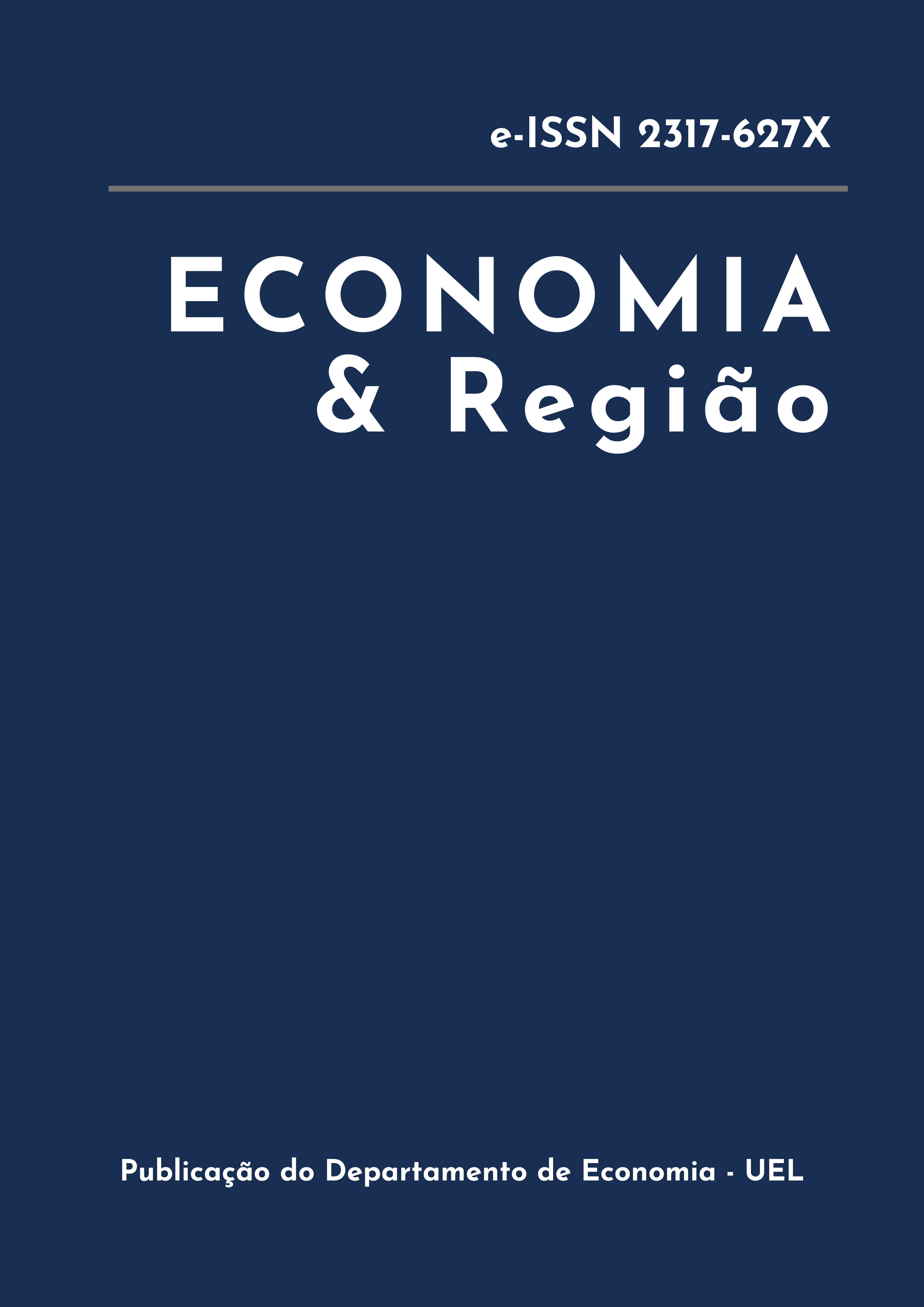Effects of income inequality on the economic growth of Brazilian states
An analysis based on a dynamic panel model with "Kink" effec
DOI:
https://doi.org/10.5433/2317-627X.2024.v12.n1.47846Keywords:
Income Inequality, Economic growth, Panel Data, ThresholdAbstract
This article aims to infer how income inequality influenced the economic growth of Brazilian states between 2002 and 2018. To investigate possible non-linearities in this relationship, the regression model for dynamic panel data with kink effect developed by Seo and Shin (2016) will be used, which deals with potential problems of endogeneity of regressors and threshold variable. Linearity tests point to a nonlinear relationship between economic growth and income inequality. Furthermore, the results for the estimated model show empirical evidence of asymmetric impacts of income inequality on economic growth, around the estimated threshold. For levels of inequality below the estimated threshold, the impact of an increase in income inequality on economic growth is positive and statistically significant; above this value, there is a negative and statically significant impact.
Downloads
References
ALESINA, Alberto; RODRIK, Dani. Distributive politics and economic growth. The quarterly journal of economics, v. 109, n. 2, p. 465-490, 1994.
ALMEIDA, F. M.; VALADARES, J. L.; SEDIYAMA, G. A. S. A contribuição do empreendedorismo para o crescimento econômico dos estados brasileiros. Revista de Empreendedorismo e Gestão de Pequenas Empresas, Macapá, v. 6, n. 3, p.
-494, Set/dez. 2017.
AMORIM, Airton Lopes et al. Desigualdade De Renda, Pobreza E Crescimento Econômico Nas Microrregiões De Minas Gerais: Evidência Empírica E Espacial Entre 1980 E 2000. In: Anais do XIV Seminário sobre a Economia Mineira [Proceedings of the 14th Seminar on the Economy of Minas Gerais]. Cedeplar, Universidade Federal de Minas Gerais, 2010.
ARELLANO, Manuel; BOND, Stephen. Some tests of specification for panel data: Monte Carlo evidence and an application to employment equations. The review of economic studies, v. 58, n. 2, p. 277-297, 1991.
ASSIS, Dercio Nonato Chaves de; LINHARES, Fabricio; PENNA, Christiano Modesto. Efeito da desigualdade no crescimento econômico dos municípios brasileiros: uma análise com base no jackknife model averaging. Revista de Economia, v. 43, n. 2 (ano 40), mai./ago. 2016.
BALASSIANO, Marcel.; TRECE, Juliana. "Taxa de investimentos no Brasil: Menor nível dos últimos 50 anos", Blog do IBRE, 01 de julho de 2019. Disponível em: https://blogdoibre.fgv.br/posts/taxa-de-investimentos-no-brasil-menor-nivel-dos-ultimos-50- anos. Capturado em 13 de dezembro de 2023.
BANERJEE, Abhijit V.; DUFLO, Esther. Inequality and growth: What can the data say? Journal of economic growth, v. 8, p. 267-299, 2003.
BARRETO, F. A. F. D.; JORGE NETO, P. M.; TEBALDI, E. Desigualdade de renda e crescimento econômico no Nordeste brasileiro. Revista Econômica do Nordeste, v. 32, p. 842-859, 2001. Número Especial.
BARRO, Robert J. Economic growth in a cross section of countries. The quarterly journal of economics, v. 106, n. 2, p. 407-443, 1991.
BARRO, Robert J. Inequality and Growth in a Panel of Countries. Journal of economic growth, v. 5, p. 5-32, 2000.
BARRO, Robert J. Determinants of economic growth in a panel of countries. Annals of economics and finance, v. 4, p. 231-274, 2003.
BENHABIB, Jess. The tradeoff between inequality and growth. Annals of economics and finance, v. 4, p. 491-507, 2003.
BERG, Andrew; OSTRY, Jonathan D.; ZETTELMEYER, Jeromin. What makes growth sustained? Journal of Development Economics, v. 98, n. 2, p. 149-166, 2012.
BERTOLA, Giuseppe. Factor shares and savings in endogenous growth. American Economic Review, n. 83, p. 1184-1198, 1993.
CASTELO BRANCO, V. C.; CAVALCANTI, T. V.; MAGALHÃES, A. M. Abertura comercial, crescimento econômico e tamanho dos estados: evidências para o Brasil. Revista Economia e Desenvolvimento, João Pessoa, v. 15, n. 1, p. 24-39, 2016.
CASTRO, R. S. Efeitos da Desigualdade de Renda sobre o Crescimento Econômico no Brasil: Uma Análise Não-Linear. Dissertação de Mestrado. UFRGS. Porto Alegre, 132 p. 2006.
CHEN, Been-Lon. An inverted-U relationship between inequality and long-run growth. Economics Letters, v. 78, n. 2, p. 205-212, 2003.
CRUZ, Aline Cristina; TEIXEIRA, Erly Cardoso; BRAGA, Marcelo José. Os efeitos dos gastos públicos em infraestrutura e em capital humano no crescimento econômico e na redução da pobreza no Brasil. Revista Economia, v. 11, n. 4, p. 163-185, 2010.
DIAS, Joilson; DIAS, Maria Helena Ambrósio. Crescimento econômico e as políticas de distribuição de renda e investimento em educação nos estados brasileiros: teoria e análise econométrica. Estudos Econômicos (São Paulo), v. 37, p. 701-743, 2007.
FORBES, Kristin J. A reassessment of the relationship between inequality and growth. American economic review, v. 90, n. 4, p. 869-887, 2000.
HAILEMARIAM, Abebe; DZHUMASHEV, Ratbek. Income inequality and economic growth: heterogeneity and nonlinearity. Studies in Nonlinear Dynamics & Econometrics, v. 24, n. 3, p. 20180084, 2019.
HOFFMANN, Rodolfo. Distribuição de renda e crescimento econômico. Estudos avançados, v. 15, p. 67-76, 2001.
INSTITUTO BRASILEIRO DE GEOGRAFIA E ESTATÍSTICA (IBGE). Sistema IBGE de Recuperação Eletrônica (SIDRA). 2018. Disponível em <http://www.sidra.ibge.gov.br>. Acesso em: 10/10/2023.
INSTITUTO DE PESQUISA EM ECONOMIA APLICADA (IPEA). IPEADATA: Banco de Dados do Instituto de Pesquisa em Economia Aplicada. Macroeconômico. 2018. Disponível em:< http://www.ipeadata.gov.br/Default.aspx>. Acesso em: out. 2023.
KALDOR, N. Alternative theories of distribution. The Review Of Economic Studies, New Jersey, v. 23, n. 2, p. 83-100, 1955.
KALDOR, Nicholas. A model of economic growth. The economic journal, v. 67, n. 268, p. 591-624, 1957.
KUZNETS, Simon. Economic growth and income inequality. The American economic review, v. 45, n. 1, p. 1-28, 1955.
LI, Hongyi; ZOU, Hengâ€fu. Income inequality is not harmful for growth: theory and evidence. Review of development economics, v. 2, n. 3, p. 318-334, 1998.
LIN, Shu-Chin et al. Nonlinearity between inequality and growth. Studies in Nonlinear Dynamics & Econometrics, v. 13, n. 2, 2009.
LINS, Leonardo Melo; ARBIX, G. Educação, qualificação, produtividade e crescimento econômico: a harmonia colocada em questão. IPEA: Anais do I Circulo de Debates Acadêmicos, 2011.
MAGALHÃES, André Matos; BRANCO, V. C.; CAVALCANTE, T. V. Abertura comercial, crescimento econômico e tamanho dos estados: Evidências para o Brasil. ENCONTRO NACIONAL DE ECONOMIA, v. 35, 2007.
MENG, Xin; GREGORY, Robert; WANG, Youjuan. Poverty, inequality, and growth in urban China, 1986-2000. Journal of comparative economics, v. 33, n. 4, p. 710-729, 2005.
OSTRY, Jonathan; BERG, Andrew; TSANGARIDES, Charalambos G. Redistribution, inequality, and growth. Revista de Economía Institucional, v. 16, n. 30, p. 53-81, 2014.
PALEOLOGOU, Suzannaâ€Maria. In search of thresholds in the household income inequality-growth relationship. Economics of Transition and Institutional Change, v. 27, n. 4, p. 989-1008, 2019.
PEROTTI, Roberto. Political equilibrium, income distribution, and growth. The Review of Economic Studies, v. 60, n. 4, p. 755-776, 1993.
PERSSON, Torsten; TABELLINI, Guido. ls lnequality Harmful for Growth. American Economic Review, v. 84, n. 3, p. 600-621, 1994.
SABOIA, João. Baixo crescimento econômico e melhora do mercado de trabalho-Como entender a aparente contradição? Estudos avançados, v. 28, p. 115-125, 2014.
SAINT-PAUL, GILLES; VERDIER, THIERRY. Education, Democracy, and Growth. Journal of Development Economics, 1993, 42(2), pp. 399-407.
SEO, Myung Hwan; KIM, Sueyoul; KIM, Young-Joo. Estimation of dynamic panel threshold model using Stata. The Stata Journal, v. 19, n. 3, p. 685-697, 2019.
SEO, Myung Hwan; SHIN, Yongcheol. Dynamic panels with threshold effect and endogeneity. Journal of econometrics, v. 195, n. 2, p. 169-186, 2016.
SHIN, Inyong. Income inequality and economic growth. Economic Modelling, v. 29, n. 5, p. 2049-2057, 2012.
STIGLITZ, Joseph E. Distribution of income and wealth among individuals. Econometrica: Journal of the Econometric Society, p. 382-397, 1969.
VOITCHOVSKY, Sarah. Does the profile of income inequality matter for economic growth? Distinguishing between the effects of inequality in different parts of the income distribution. Journal of Economic growth, v. 10, p. 273-296, 2005.
ZHANG, Yonghui; ZHOU, Qiankun; JIANG, Li. Panel kink regression with an unknown threshold. Economics Letters, v. 157, p. 116-121, 2017.
Downloads
Published
How to Cite
Issue
Section
License
Copyright (c) 2023 Rodolfo, Thiago Geovane Pereira Gomes Gomes, Alderir, Danilo, Vagner

This work is licensed under a Creative Commons Attribution 4.0 International License.
Economia & Região adota a Licença Creative Commons Attribution CC-BY 4.0 International, portanto, os direitos autorais relativos aos artigos publicados são do(s) autor(es), que cedem à Revista Economia & Região o direito de exclusividade de primeira publicação.
Sob essa licença é possível: Compartilhar - copiar e redistribuir o material em qualquer suporte ou formato. Adaptar - remixar, transformar, e criar a partir do material, atribuindo o devido crédito e prover um link para a licença e indicar se mudanças foram feitas.




















